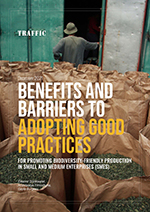Why financing is tied to the future of a biodiverse planet

New report shows different financing possibilities aiming at the conservation of biodiversity.
The report on "Finance that Works for Biodiversity" that has been released by Deutsche Gesellschaft für Internationale Zusammenarbeit GmbH (GIZ) and World Agroforestry (ICRAF) recently stresses the importance of biodiversity funding, calls for new funding instruments and recommends to view biodiversity as an economic asset.
The report is based on discussions and insights from a corresponding workshop that took place on 24 and 25 June 2019 in Bonn. At that time, around 40 experts from 7 countries dealt with the question of how to channel financial resources into the protection of biodiversity. Representatives from the private and financial sectors as well as governmental and non-governmental organisations discussed new ideas for cooperation between the private and public sectors to protect biodiversity.
GIZ and ICRAF brought together financing experts from six projects funded by the German Federal Ministry for the Environment, Nature Conservation, and Nuclear Safety (BMU) through its International Climate Initiative (IKI) for this global learning and knowledge-exchange event. Public- and private-sector experts from Africa, Asia, Europe and Latin America shared their experience of directing investments into biodiversity-friendly food production.
The experts called for new financial incentives for a transformative model of agriculture that is friendly to biodiversity and provides nutrition throughout the year for agricultural communities and people who buy their products. Such a transformation will blend agriculture with conservation and contribute to the United Nations Decade on Ecosystem Restoration.
An important argument was that the private sector and, often, governments, will implement the necessary transformation of agriculture if investment leads to improved incomes, livelihoods and nutrition. Thus, it is the role of the research community to demonstrate that investment into biodiversity supports governments to reach their ambitious development goals while de-risking supply chains for the private sector.
The attendees of the workshop discussed existing finance products and blended-finance instruments that intend to promote biodiversity-friendly production.
The report with detailed information about the workshop and the results of the discussions is available for download here.
The link has been copied to the clipboard
Contact
IKI Office
Zukunft – Umwelt – Gesellschaft (ZUG) gGmbH
Stresemannstraße 69-71
10963 Berlin
Related Publications
-
 09/ 2022 | Publication types | Guideline
09/ 2022 | Publication types | GuidelineAgroforestry a Primer: Design and management principles for people and the environment
English (PDF, 10 MB)











